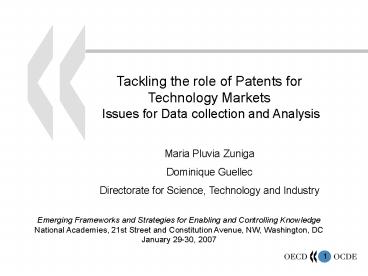EPO Patent applications - PowerPoint PPT Presentation
1 / 11
Title:
EPO Patent applications
Description:
Tackling the role of Patents for Technology Markets Issues for Data collection and Analysis Maria Pluvia Zuniga Dominique Guellec Directorate for Science, Technology ... – PowerPoint PPT presentation
Number of Views:75
Avg rating:3.0/5.0
Title: EPO Patent applications
1
Tackling the role of Patents for Technology
Markets Issues for Data collection and
Analysis Maria Pluvia Zuniga Dominique
Guellec Directorate for Science, Technology and
Industry
Emerging Frameworks and Strategies for Enabling
and Controlling Knowledge National Academies,
21st Street and Constitution Avenue, NW,
Washington, DCJanuary 29-30, 2007
2
Outline
- Introduction
- Patents and Technology Markets
- Patterns
- Policy concerns
- Measurement of Technology Diffusion
- Experience in Surveys
- Projects for Data Collection
3
1. Introduction
- What is the role of patents in the functioning of
new infrastructures for knowledge? - Through disclosure, patents increase knowledge
diffusion - Through market transactions (licensing..),
patents facilitate technology diffusion - But patents may also restrain access to
technology and limit development of capabilities
innovation - How to deal with patent rights to ensure access
and fluidity in cyber-infrastructure? - To date, more anecdotal than empirical evidence
- Need to quantify understand uses of patents and
exploitation strategies
4
2. Patents and Technology Markets (1)
- Business Tendencies
- Shift to Open Innovation models where external
links play a more prominent role both in the
creation and production of technology - Licensing-out to recoup the costs of innovation
face to faster peace of innovation - Licensing-in to leverage technological assets and
complement internal capabilities - Different forms of partnerships, -purely
licensing, equity financing, cross-patent
pooling, etc. - Increasing adoption of IAM practices
(Intellectual Assets Management) to increase
business value
5
3. Patents and Technology Markets (2)
- Theoretical Foundations
- Patents help to
- Facilitate the provision of complementary tacit
knowledge (i.e. know how, technical assistance,
etc.) - Better allocation of resources through a more
efficient division of labour amongst firms (e.g.
fabless companies) - Technology markets help to
- Prevent RD duplications, increase diffusion of
public and private RD outcomes
6
4. Patents and Technology Markets (3)
Patents as obstacles
- Strategic uses (submarine, sleeping patents,.)
Blocking entrants/competitors limiting
technology alternatives - Anti-commons tragedy under-utilization of
technology too many owners blocking each other - E-based infrastructures (eg.e-bussiness models,
e-science..)? - Avoiding tragedy requires overcoming transaction
costs, strategic behaviours, and cognitive biases
of participants - Conciliate upstream creation/downstream
development
7
5. Patterns
- Growing but under-exploitation of patenting
- World-wide licensing transactions average more
than USD 36 billion per year between 1990 and
1997, compared to 5.6 billion in the 1980s - ? 100 billions USD in 2002 (Athereye Cantwell,
2005) - PATVAL-EU Survey Less than 10 of patents are
subject to licensing (out) but - 10-15 Willing to be licence 50 potential
increase in the size of the market - 35 of patents are not used at all blocking
18.7, sleeping 17.4 - JPO Survey 8 of JPO patents are licensed, and
7 are unsuccessfully offered to license
8
6. Policy Concerns
- How to enhance licensing by technology producers
in the interest of both buyers and sellers? - How to unlock (latent) economic value of
patents? - How to improve access to technology?
- Reduce anticommons (patent thicket) and foster
RND (Reasonably Non Discriminatory Practices)
9
7. Measurement of technology diffusion
- Key issue for Analysis and Policy Evaluation
- Significant advances in (International) Patent
Data (e.g. PATSTAT). Allows to track - Patenting strategy (e.g. technology blocking,
continuations) and trends across patent systems - Knowledge Diffusion effects
- Limited data on technology markets. Need of
uniform, consistent and relevant indicators - What are the motivations for licensing-in and
out? (strategic/defensive, constrained
licensing, technology-oriented strategies)?
10
8. Experience in Surveys
- 1994 Carnegie Mellon Survey (Yale 2 USA) on the
effectiveness of patents in protection - JPO Survey (Japan) Uses of IPR and types of
licensing - 2005/2006 EPO Survey Motivations for patenting
and proportion of patents in each category. - 2003 OECD-BIAC Survey In and out-licensing
strategies (100 Large MNE) - 2002-2003 PATVAL Survey on the Uses Value of
patents (patent/inventor basis) - ? Various limitations (e.g. response rates,
limited geographical coverage and comparability,
representativity baises, etc.) - ? Tangible need for international coordination
11
9. Projects for Data Collection
- International Survey on the Economic Use and
Impact of patents. Current partnership OECD-EPO,
and possibly others..? - To built-on previous expertise (e.g. JPO, EPO,
LESI and OECD surveys) - Largest geographical coverage broader
population (including large, SMEs and start-ups). - Gather detailed information on companies
strategies in using and exploiting patents. E.g.
items - Purposes of using patents and their relative
importance (strategic, financial, protection,
etc.) - Motivations/and types of licensing practices
(in/out) - Obstacles (e.g. infiringement, litigation,
limited enforcement, etc.) as buyer or seller of
technology - Impact of Licensing strategies on value and
diffusion































